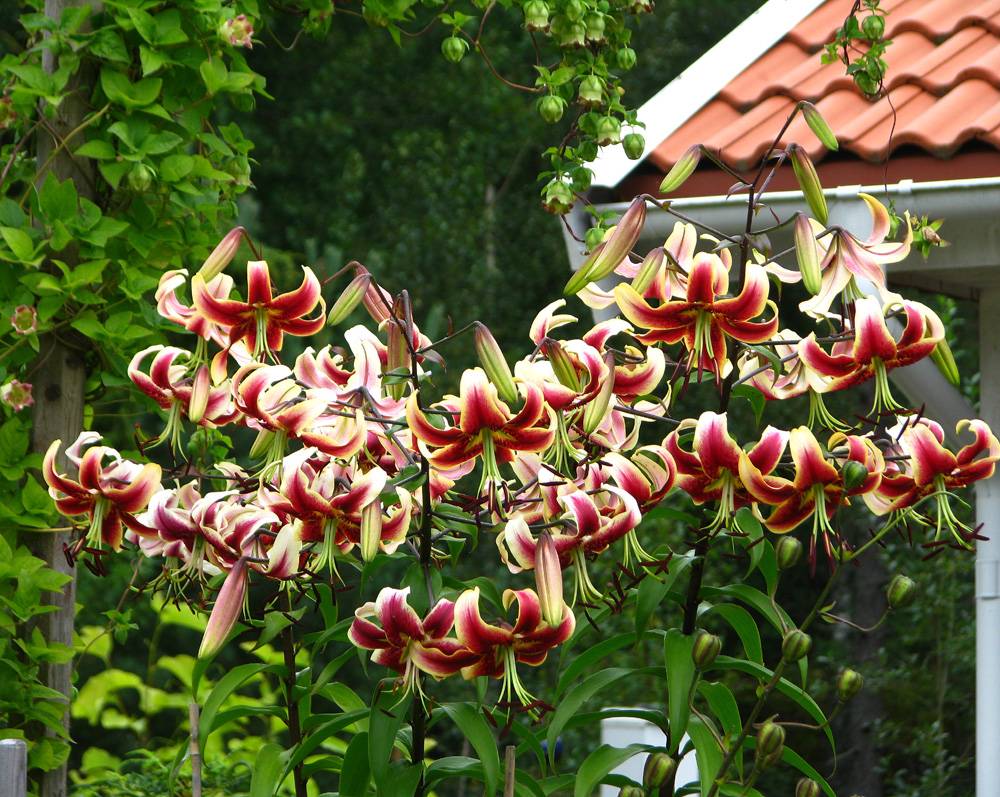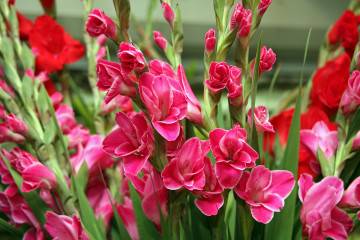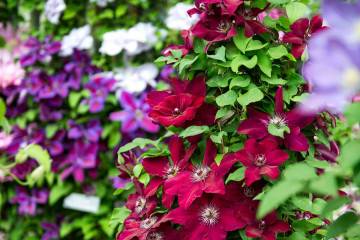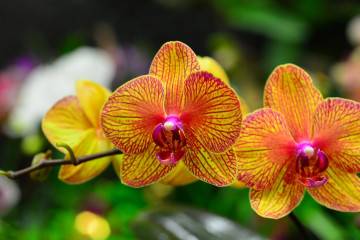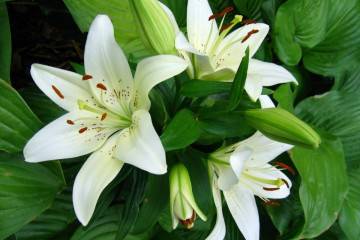How to feed lilies in autumn and spring before flowering
Content:
Delicate and majestic lilies can decorate any garden area. But, even having acquired high-quality planting material, not every gardener can grow a healthy plant and achieve its flowering. The secret lies in the correct feeding of the flower at different stages of its development.
How to feed lilies
Knowing when and what fertilizers to use to feed lilies can greatly influence their flowering. The technique of procedures during the season is somewhat different.
Feeding lilies throughout the year: recommendations for beginners
For those who are just starting to grow lilies, it will be useful to familiarize yourself with the basic rules for feeding. First of all, the florist must take into account that:
- flowering crops should be fertilized with inorganic compounds;
- fertilizer is applied after watering;
- the first feeding occurs at the time of sprouting. The composition of the complex fertilizer must necessarily include nitrogen, which contributes to the collection of green mass. With a frequency of 2 weeks, 2 more similar procedures are carried out;
- during the budding period of the plant, it is recommended to fertilize with potassium and magnesium to ensure the brightness and splendor of the inflorescences;
- during the flowering period, feeding is carried out less often.
In addition to the points listed, there are others that should also be considered when fertilizing flowers planted in the ground.
Application technology and composition of fertilizers
To saturate the soil with nutrients, organic compounds and mineral complexes are used. Top dressing should be done as carefully as possible so as not to harm the bulbs.
Spring feeding for lush bloom
In the spring, after the snow melts and the soil warms up to 6 ° C, the planting of bulbs is fertilized with nitrogen-containing dressings (urea or ammonium nitrate). It is these compounds that stimulate the growth and development of the plant. They are bred in settled water and poured under the root, avoiding contact with the leaves. About 1 bucket of ready-made mortar is consumed per 1 m².
If a granular preparation is used, then it is scattered over the soil surface at the rate of 2 tbsp. spoons per 1 m². It is advisable to pour a small layer of mulch or soil on top so that the dry matter is not scattered by gusts of wind.
When a plant begins to set buds, it needs phosphorus. The best way to feed the flower in this case is to use the foliar technique.
Summer feeding
In summer, a lower concentration of fertilizing is used for fertilization. The procedure is recommended in July, using the liquid form of nutrients.
Superphosphate and potassium magnesium are considered optimal for summer feeding of lilies.It is the elements included in their composition that strengthen the plant and make the color of the flowers more saturated.
Autumn feeding
After flowering is complete, depleted bulbs also require a restorative potassium and phosphorus supply. After a single mineral feeding, the introduction of inorganic substances is reduced so as not to cause active growth of the aboveground part of the plants. Optimal in the autumn will be mulching the planting of lilies with organic matter (humus, compost mixtures, manure) to a height of 10 cm.
Why fertilizing lilies is important
Each year, the aerial part of the plant dies off by the end of the season, and new shoots appear in the spring from overwintered bulbs. Young flowers get the main part of nutrients from accumulated reserves.
What can not be fed lilies
Lily bulbs are very delicate and sensitive, so it is unacceptable to fertilize them with fresh, not rotted manure. Such a powerful top dressing can burn the plant, as a result of which it will be captured by a fungal infection and the flower will die.
The best time to fertilize
When applying top dressing, it is imperative to take into account the climatic and weather conditions. By the time of the first procedure, the soil should be warmed up to at least 6 ° C. In most regions, this happens in April-May.
How to fertilize lilies
The area where lilies are planted should be fertilized throughout the season. The procedures should be timed to coincide with certain vegetative stages in the development of the plant.
Fertilizing lilies when planting
Experienced growers know exactly when to plant lilies. Planting a bulbous crop is preferable in early spring or late autumn. It is worth considering that flowers love a light and loose soil, rich in humus. Additionally, when lilies are planted in open ground, the rotted compost mixture is mixed into it.
Also, urea can be used as a nutritional component at the rate of 20 g per 1 m². To stimulate the formation of buds and abundant flowering, potassium sulfate and superphosphate are introduced during planting.
Top dressing during budding before flowering
Feeding lilies before flowering should include potassium and phosphorus. Commercially available formulations usually contain these elements and are very convenient to use. Prepare the solution from the concentrate immediately before use, strictly following the instructions on the package.
When deciding how to feed lilies in June before flowering, it is better to opt for complex formulations. After fertilization during the budding period, the soil is sprinkled with mulch from sawdust or mowed grass. Watering the plants during this time should be abundant and regular, but not too often, as this is harmful to the bulbs.
How to feed lilies in June during flowering
Ammophosk helps to achieve the brightness of flower petals during the flowering period. Thanks to this fertilizer, plants acquire resistance to various external influences (weather changes, cutting), as well as to various diseases and insect pests.
Top dressing after cutting or flowering
In the fall, lilies are prepared for wintering, so they need special nutrition. Starting in August, the soil in the place of lily plantings is fertilized with complexes containing superphosphate and potassium sulfate.It is unacceptable to introduce nitrogen-containing compounds in the fall, otherwise the plant, instead of going into hibernation, will begin to grow and at the time of the onset of cold weather it will freeze.
The optimal use in the autumn months is the use of fermented compost or rotted manure. In this case, the soil will not only be enriched with nutrients, but will also be reliably insulated against the onset of frost.
Lily transplant after flowering
Lilies can grow in the same place for no more than 5 years. Next, they need a transplant, otherwise the plants will begin to degenerate, and the flowers will become smaller. It is also worth taking into account the growth of the mother's bulbs, around which babies have time to form in several years, they must be transplanted.
Lilies are transplanted in the fall. At this time, the bulbs adapt better to the new site, and there is no need to store them. The exact timing of the transplant depends on the climate. In the Moscow region, it is desirable to carry out planting work in August-September. In regions with milder conditions, lilies are moved later, closer to October.
Soil selection
The quality of lily blooming is determined by the soil composition. Before planting lilies, the soil at the planting site is carefully dug up, making it loose and breathable. Stagnation of moisture is unacceptable, otherwise the bulbs will simply rot. To facilitate the removal of moisture, peat and river sand are usually added to the soil.
Top dressing when transplanting
The soil under the flowerbed with lilies is dug up in advance, adding superphosphate and potassium sulfate. If deoxidation of the soil is necessary, then chalk, lime or dolomite flour must be added.
Lilies are no more demanding than other flowering crops. Having taken up their cultivation in the garden, the florist must provide full care and make the necessary fertilizing in a timely manner. By adhering to the above rules, you can get luxurious, abundantly and brightly flowering lily bushes.
